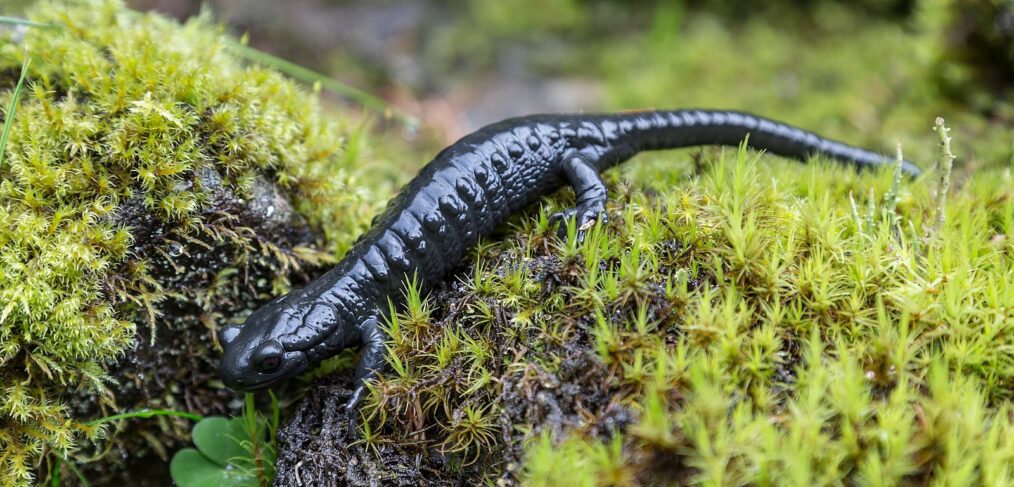
Species of the week #107 – Alpine Salamander
Do you know the “Bergmandl” – the little mountain man? That’s what the Alpine salamander is called in the Berchtesgaden region. It is agile, likes bad weather, loves the mountains and is poisonous – at least for its predators. Only alpine choughs or jackdaws eat the alpine salamander before it can activate its poison glands. Egg thieves are also unlucky with the Alpine salamander: it is the only amphibian to have living young.
| Distribution status in Germany | very rare |
| Remaining occurance | Alpine region |
| Last sightening in Germany | current |
| Habitat | Cool, light mixed deciduous forests near streams above 800 m NN |
| Threats | Habitat fragmentation and destruction, traffic, climate change |
The Alpine salamander is 12 to 16 centimetres in size and uniformly lacquer-black in colour; males are somewhat smaller. Alpine salamanders are mainly nocturnal and feed on animal prey such as insects, spiders, various larvae, isopods, snails and earthworms.
Unlike most other amphibians, which lay their spawn in water and whose offspring go through a larval stage with gill breathing, alpine salamanders are born fully developed and viable on land immediately. Alpine salamanders give birth to one to two young, which are only four centimetres long and have no gills. The Alpine salamander is the only Central European amphibian that can exist independently of surface waters – an adaptation to the extreme living conditions in the high mountains.
The Alpine salamander lives in karst areas and high mountain gorges in the middle and high altitudes of the Alps from 800 – 1000 metres. Only rarely are specimens found at lower altitudes. Their activity is strongly dependent on the ambient temperature and humidity – the latter should be around 85 percent. This is why Alpine salamanders are best observed during light rainfall or in the early morning.
Due to its special habitat requirements, the Alpine salamander is only found in a few areas. Although the population is currently classified as stable, the occurrence of the Alpine Salamander is threatened mainly by the following factors: Habitat loss due to the construction of new forest roads, ski slopes and snow-making facilities; loss of individuals on forest roads and alpine paths due to motor vehicles and bicycles; conversion of mixed mountain forests into spruce stands; removal of dead wood. The animals are extremely site-faithful, their habitat often covers only a few square metres. Therefore, they are very sensitive to changes in their environment. In addition, the extremely long gestation period of two to five years, depending on the habitat, makes adaptation difficult.
Climate change could further worsen living conditions due to drought and extreme precipitation, especially in the lower altitudes of the range. Overall, Alpine salamanders are currently considered “not endangered”, but their exact distribution and numbers of individuals are not known.
Political necessity:
- Conservation of habitats
- Continuation of FFH species monitoring in the Alpine region
- Avoidance of construction measures with habitat fragmentation effects
Click here for more exciting species of the week
Photo: By styko – Own work, CC BY-SA 4.0, https://commons.wikimedia.org/w/index.php?curid=41196478
